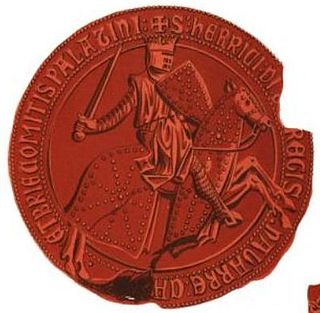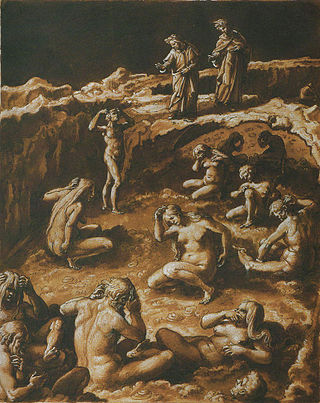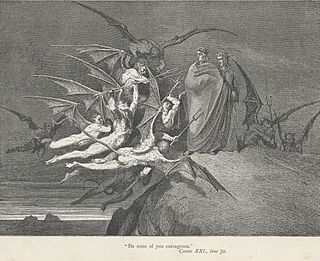
The Divine Comedy is an Italian narrative poem by Dante Alighieri, begun c. 1308 and completed around 1321, shortly before the author's death. It is widely considered the pre-eminent work in Italian literature and one of the greatest works of world literature. The poem's imaginative vision of the afterlife is representative of the medieval worldview as it existed in the Western Church by the 14th century. It helped establish the Tuscan language, in which it is written, as the standardized Italian language. It is divided into three parts: Inferno, Purgatorio, and Paradiso.
In Greek mythology, the river Phlegethon or Pyriphlegethon was one of the five rivers in the infernal regions of the underworld, along with the rivers Styx, Lethe, Cocytus, and Acheron. Plato describes it as "a stream of fire, which coils round the earth and flows into the depths of Tartarus". It was parallel to the river Styx. It is said that the goddess Styx was in love with Phlegethon, but she was consumed by his flames and sent to Hades. Eventually, when Hades allowed her river to flow through, they reunited.

Henry the Fat was King of Navarre and Count of Champagne and Brie from 1270 until his death.

Theobald II was King of Navarre and also, as Theobald V, Count of Champagne and Brie, from 1253 until his death. He was the son and successor of Theobald I and the second Navarrese monarch of the House of Blois. After he died childless, the throne of Navarre passed to his younger brother, Henry I.

Purgatorio is the second part of Dante's Divine Comedy, following the Inferno and preceding the Paradiso. The poem was written in the early 14th century. It is an allegory telling of the climb of Dante up the Mount of Purgatory, guided by the Roman poet Virgil – except for the last four cantos, at which point Beatrice takes over as Dante's guide. Allegorically, Purgatorio represents the penitent Christian life. In describing the climb Dante discusses the nature of sin, examples of vice and virtue, as well as moral issues in politics and in the Church. The poem posits the theory that all sins arise from love – either perverted love directed towards others' harm, or deficient love, or the disordered or excessive love of good things.
Barbariccia is one of the demons in the Inferno of Dante Alighieri's Divine Comedy. Barbariccia is one of the Malebranche, whose mission is to guard Bolgia Five in the Eighth Circle, the Malebolge. Barbariccia's name means "curly beard" in Italian. Barbariccia seems to be the most important devil after Malacoda as he becomes the "provost" of nine other devils, when Malacoda commands them to escort Dante and Virgil, which can be read out of the following text :

Cagnazzo is one of the Malebranche in Dante's Inferno, appearing in Cantos XXI, XXII and XXIII.

In Dante Alighieri's Inferno, part of the Divine Comedy, Malebolge is the eighth circle of Hell. Roughly translated from Italian, Malebolge means "evil ditches". Malebolge is a large, funnel-shaped cavern, itself divided into ten concentric circular trenches or ditches. Each trench is called a bolgia. Long causeway bridges run from the outer circumference of Malebolge to its center, pictured as spokes on a wheel. At the center of Malebolge is the ninth and final circle of hell.

Devil May Cry 3: Dante's Awakening is a 2005 action-adventure game developed and published by Capcom. The game is a prequel to the original Devil May Cry, featuring a younger Dante. Set a decade before the events of the first Devil May Cry in an enchanted tower, Temen-ni-gru, the story centers on the dysfunctional relationship between Dante and his brother Vergil. The game introduces combat mechanics with an emphasis on combos and fast-paced action. The story is told primarily in cutscenes using the game's engine, with several pre-rendered full motion videos.

Sordello da Goito or Sordel de Goit was a 13th-century Italian troubadour. His life and work have inspired several authors including Dante Alighieri, Robert Browning, and Samuel Beckett.

Malacoda is a character in Dante Alighieri's Inferno, where he features as the leader of the Malebranche, the twelve demons who guard Bolgia Five of Malebolge, the eighth circle of Hell. The name Malacoda is roughly equivalent to "bad tail" or "evil tail" in Italian. Unlike other characters such as Geryon, which are based on mythical characters, Malacoda was invented by Dante and is not a mythological reference.

Inferno is the first part of Italian writer Dante Alighieri's 14th-century epic poem Divine Comedy. It is followed by Purgatorio and Paradiso. The Inferno describes Dante's journey through Hell, guided by the ancient Roman poet Virgil. In the poem, Hell is depicted as nine concentric circles of torment located within the Earth; it is the "realm ... of those who have rejected spiritual values by yielding to bestial appetites or violence, or by perverting their human intellect to fraud or malice against their fellowmen". As an allegory, the Divine Comedy represents the journey of the soul toward God, with the Inferno describing the recognition and rejection of sin.

Paradiso is the third and final part of Dante's Divine Comedy, following the Inferno and the Purgatorio. It is an allegory telling of Dante's journey through Heaven, guided by Beatrice, who symbolises theology. In the poem, Paradise is depicted as a series of concentric spheres surrounding the Earth, consisting of the Moon, Mercury, Venus, the Sun, Mars, Jupiter, Saturn, the Fixed Stars, the Primum Mobile and finally, the Empyrean. It was written in the early 14th century. Allegorically, the poem represents the soul's ascent to God.
Calcabrina is one of the demons featured in Inferno, the first canticle of Dante Alighieri's Divine Comedy. Calcabrina's name is possibly meant to mean "grace-stomper" or "frost trampler."

The Malebranche are the demons in the Inferno of Dante's Divine Comedy who guard Bolgia Five of the Eighth Circle (Malebolge). They figure in Cantos XXI, XXII, and XXIII. Vulgar and quarrelsome, their duty is to force the corrupt politicians (barrators) to stay under the surface of a boiling lake of pitch.

Alichino is one of the devils in the Inferno of Dante Alighieri's Divine Comedy. Alichino is a member of the Malebranche, whose mission is to guard Bolgia Five in the Eighth Circle, the Malebolge. Alichino's name is commonly regarded as a garbled version of the Italian word for harlequin, Arlecchino, perhaps for his flying attempt to catch Ciampolo of Navarre in his escape. His only significant contribution to the plot is when he persuades the other devils to leave Ciampolo of Navarre alone. Ciampolo is supposed to summon other sinners from the lake of boiling pitch, on request by Dante. But Ciampolo doesn't call at his friends. Instead, he fools the devils and escapes back to the lake, and Alichino tries in vain to catch him. This causes a fight between Alichino and Calcabrina, which causes them to fall into the lake. The other devils put the blame on Virgil and Dante, though and hunt them vexed.

Vanni Fucci di Pistoia was a 13th-century Italian and a minor character in Inferno, the first part of Dante Alighieri's epic poem the Divine Comedy, appearing in Cantos XXIV & XXV. He was a thief who lived in Pistoia, as his name indicates; when he died, he was sent to the seventh bolgia of the eighth circle of Hell, where thieves are punished. In that bolgia, his punishment was to be stung by a serpent, reduced to ashes, and then restored to his former shape for more torturing. Dante and Virgil meet him and ask him why he was there. He replied that he stole a treasure from the Church of St. James in his hometown; he had wrongly accused an innocent man, Vanni della Nona, with the crime, for which della Nona was executed. Fucci says he was not caught but he still went to Hell. He then predicts the overthrow of the Florentine Whites to spite Dante and then insults God by making obscene gestures at him, and is attacked by numerous nearby serpents and by the monster Cacus, who was put in the bolgia for stealing Hercules's cattle.

Matelda, anglicized as Matilda in some translations, is a minor character in Dante Alighieri's Purgatorio, the second canticle of the Divine Comedy. She is present in the final six cantos of the canticle, but is unnamed until Canto XXXIII. While Dante makes Matelda's function as a baptizer in the Earthly Paradise clear, commentators have disagreed about what historical figure she is intended to represent, if any.

Bonconte I da Montefeltro was an Italian Ghibelline general. He led Ghibelline forces in several engagements until his battlefield death. Dante Alighieri featured Montefeltro as a character in the Divine Comedy.
Ciriatto is one of the Malebranche in Dante's Inferno, appearing in Cantos XXI, XXII and XXIII.















